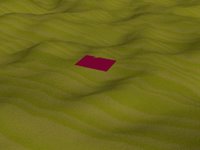I am currently trying to find the quickest way of camera calibration available. The reason for speed needs is first and foremost that the application should be able to run in a live video feed. This means that every part of the algorithm which is not optimized can be seen as a bottleneck....
If I had the cameras available, I could use a camera calibration pattern to find the needed intrinsic parameters. Obviously I don't have this possibility.
In the case of having some known measurements in the image, which could be related to how much space these take in the projected image, I could calculate the necessary parameters from the use of those. Of course I have no such measurements in this case - however, I could possibly get them if absolutely necessary, but then I would probably have to handle some politicians and red tape or the like....
One option I am considering is to reconstruct the environment in a 3D model, where I could put the finished models on top and then simply smile and be happy. This could actually be the most interesting option in the end - since it would also give the possibility of pausing the live video feed and let the user "fly down" and take a closer look on the environment at any place of choice. I believe I would enjoy the result of this :-)
Another option is to find the calibration matrix "backwards". Meaning that we already have the three vanishing points, which can be used to find the image of the absolute conic, and in turn the camera calibration matrix. This option will probably not be possible to use for a video sequense shot from a plane, with a minimal set af of parallell lines. However, in an in-door scene, this would probably be my choice of method.
I'll write back here again when finding more algorithms, and after deciding for which to use - bear in mind that I haven't even seen the video sequence yet - or the 3D models we're supposed to insert ;-)


